Submission Deadline-26th December 2025
Last Issue of 2025 :
Publication Fee: 30$ USD
Submit Now
Submission Deadline-27th December 2025
Special Issue on Economics, Management, Sociology, Communication, Psychology:
Publication Fee: 30$ USD
Submit Now
Submission Deadline-19th December 2025
Special Issue on Education, Public Health:
Publication Fee: 30$ USD
Submit Now
Time Dark Matter Geometrical Model and Newton’s Law Recovery
- Saoussan A. Kallel-Jallouli
- 406-414
- Apr 17, 2024
- Physics
Time Dark Matter Geometrical Model and Newton’s Law Recovery
Saoussan A. Kallel-Jallouli
Université de Tunis El Manar, LR03ES04, Faculté des Sciences de Tunis, 2092, Tunis, Tunisia,
DOI: https://doi.org/10.51584/IJRIAS.2024.90337
Received: 23 February 2024; Revised: 13 March 2024; Accepted: 18 March 2024; Published: 17 April 2024
ABSTRACT
Recently, a new geometrical model was proposed to solve the problem of “time”. Moreover, the proposed model offers a solution for the dark matter enigma. In this work, we explain how Newton’s law of rotation is an immediate consequence of the proposed “time” model. Furthermore, a more general formula is required for the acceleration of a particle to be more accurate. This explains our need for the Einstein theory of gravitation.
Keywords: Time, dark matter, velocity, acceleration
PACS number(s): 04.20. Gz, 95.35. +d, 06.30. Gv, 06.30. Gv, 96.50. Pw, 96.50. Pw, 45.50. Dd
INTRODUCTION
The majority of the energy stuff in the cosmos cannot be regular matter, which was one of the fascinating scientific discoveries of the 20th century. It is another type of matter that interacts with classical matter through its gravitational effect. Scientists have called this new stuff “Dark matter” (DM). The type and physical properties of DM are enigmatic (Young 2017). We cannot see DM, but we can know it is there by its gravitational impact on seen matter.
In previous work (Kallel-Jallouli 2018; 2021 a,b,c), Saoussan Kallel proposed the existence of invisible unusual stuff, named “Zaman”, responsible for the variations of “time” by its rotational motion (Kallel-Jallouli, 2023a,b). The proposed model led to the formation of rings, or multiple images of the same object, then, to the self-evident conclusion that “Zaman” exists, and it solves the DM enigma. In this work, using the new definition of “time”, we shall explain how to recover Newton’s law of rotation. Let us begin by recalling the new geometrical model.
THE “ZAMAN” GEOMETRICAL MODEL
Introduction
The concept of time is complex. For many decades, the difficulty of giving a complete account of “time” remained unresolved (DeWitt 1967; Earman 1987; Isham 1993; Kucha ̌r 1999; Merali 2013; Rovelli 1991; Smolin 2014; Wheeler 1968). Most scientists just see time as what clocks measure, so we may as well disregard it (Barbour 2001; Magueijo and Smolin 2019; Smolin 2001). The problem of “time” remained unsolved until the new revolutionary idea proposed by Pr. kallel in 2018 (Kallel-Jallouli 2018). She believed time is not simply a question of order of events (Rovelli 2018), or a real or complex variable. She succeeded, using the Dark Matter strong lensing effect, to demonstrate the existence of an unusual kind of unseen staff called “Zaman” responsible for the variations of “time” by its spin (Kallel-Jallouli 2021).
The idea proposed in the new theory is very interesting and helps scientists obtain a better understanding of our physical universe. We shall see how, using the new physical perception of “time”, things are more rigorous.
A NEW GEOMETRICAL MODEL
1. Definition of U-day (Kallel-Jallouli 2018, 2021, 202)
U will be a spinning sphere (generally called “universe” or “halo”), automatically filled with “Zaman”. Assume U has a solid body rotation and that, in comparison to its non-rotating (inertial) state UI, it takes T units of clock-time, for U, to complete one rotation in the positive direction about its axis. If the rotational speed of U is constant and repeatable, then T is the length of the U-day. One U-day is equal to one full rotation of U in the positive direction around its axis. The U-day’s length is determined using a chosen clock (habitually expressed in seconds). Evidently, the clock is an instrument used just to fix the length T of the physical U-day.
2. Definition of U-time inside U
Let us choose the spherical coordinate system (r,θ,φ), given by figure 1
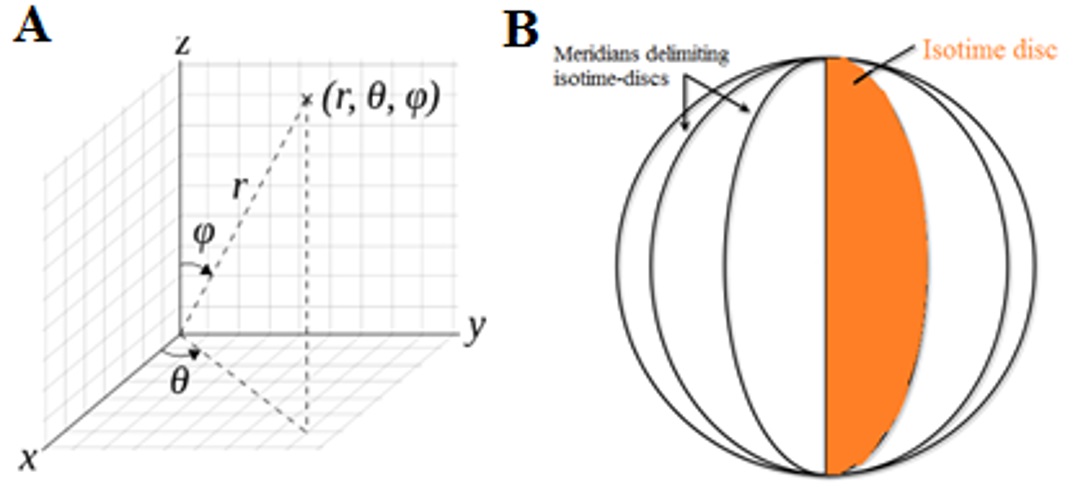
Figure 1. A. Spherical Coordinates. B. Isotime-discs (Kallel-Jallouli 2021)
U-time will be the same for a solid body rotation over each semidisc limited by the axis of rotation and a meridian (figure 1).
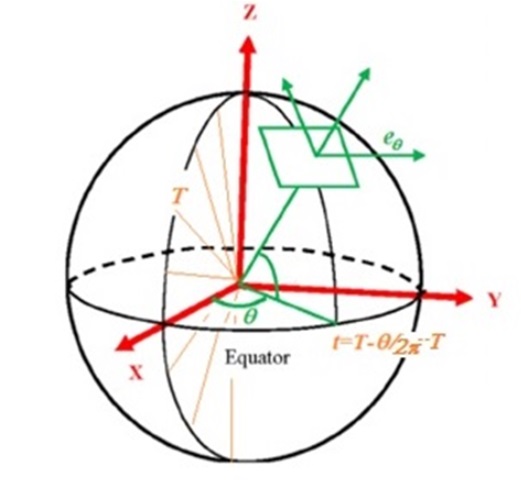
Figure 2. U-time inside U
Let us select the isotime-disc enclosed in the plane (Oxz) as the semidisc of U-time 0 (tu≡0). It is called the U-prime meridian (figure 2). Any certain point P in UI with coordinates (r, θ, φ) concurrently indicates the space position (r, θ, φ) and the U-time variation in relation to the U-prime meridian, provided for the first day by (Kallel-Jallouli 2021b, c, d):
This is how internal U-time varies, in one U-day. For the nth day, U-time is provided by:
The value of U-time inside UI is tu
3. U-time difference between two points inside the UI.
The following formula is used to determine the U-time difference between two sites inside of U for the same day based on the difference in longitude:
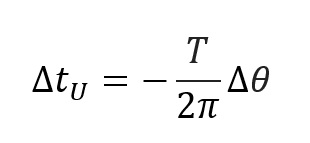 (2.3)
(2.3)4. A particular example: the classical time
When 𝑇=24 hours, then
The classical variation of time is the variation of U-time:
Remarks.
1. In this classical case,
* 360 degrees corresponds to one U-day of length 24 hours
* 180 degrees corresponds to half a U-day of length 12 hours
* 15 degrees corresponds to 1 hour
Let us call this “universe”, the classical “universe”, and the corresponding U-time, the classical time.
2. if T>24 hours, then ∆tu>∆tc, and U-time is stretched, with respect to the classical time. If T<24 hours, then ∆tu<∆tc and U-time is shrunken with respect to the classical time.
Actual physical rules inside of U must be based on U-time, which is tied to the actual spin of U, rather than clock time, which has no physical relation with the U-spin.
NEWTON’S LAWS FOR ROTATION
1. U-celerity
Let ‘s consider a spinning spherical halo Uo with rigid body rotation, with constant angular velocity Ωo (remember that angular velocity is related to the length of the Uo-day by: Ω0=2π/To ), about a fixed axis (z-axis) passing through its centre O, relative to its nonrotating inertial frame of reference. According to Newton’s first law of rotation, Uo will continue to rotate at the same angular velocity unless it experiences an external torque. If a tracer particle P is placed inside Uo, at a distance r from the origin, then it follows circular orbits around the central axis with tangential velocity given by Newton’s law of rotation:
Now, we seek to retreeve this formula using our revised concept of U-time.:
Theorem 1
The Uo-velocity of P given by (using our new definition of Uo-time):
satisfies the relation:
Proof
P will rotate in a circle of fixed radius (rsinφ). This circle has the Uo-axis of rotation as the axis. Note that if the particle completes one revolution, θ will not become zero again, but 2π rad, corresponding to one Uo-day. Consider the particle to be at point Pi, which corresponds to angular position θi, at Uo-time ti. Once a Uo-time ∆tUo passed, the particle changed to point Pf, which represents the angular position θf, at Uo-time t_f. Its angular displacement given by ∆θ=θ_f-θi is positive for counterclockwise rotation (increasing θ). The Uo-time it takes for the particle to pass from Pi to Pf must be based on the difference in “time” between the two points, so, using relation (2.4), we must have:

By definition (3.2) of the U0-radial velocity of a particle P inside Uo,
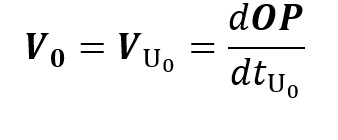
Using relation (3.4), we can write, with O’ the projection of P on the z-axis:

Finally, we can deduce:
This means the equality between the known Newton’s tangential velocity V0N given by (3.1), and the
Uo-velocity VUo given by (3.2) (based on Uo-spin) of a test particle living inside Uo.
2. U-acceleration
For the test particle P, Newton’s acceleration using Uc-time is given by:

By applying relation (3.1), we obtain
The tangential component:
The radial component:
Let us denote: dt0≡dt_(Uo ). If the spherical halo Uo rotates with constant angular velocity Ω0, then, based on our new definition of Uo-time, a tracer particle P will have an Uo– acceleration defined by:

Since, for constant angular velocity, we have (dΩ0)/(dt0 )=0, then we conclude that
We find the same relation (3.8) of the radial acceleration given by Newton’s law.
If Ω_0 varies with time, then, Uo-time inside Uov varies. We will have
Theorem 2
The Uo-acceleration of a test particle P inside Uo defined by
 (3.10)
(3.10)satisfies:
 (3.11)
(3.11)In the particular case TUo =Tc, we obtain the equality between the Uo-acceleration and Newtonian’s acceleration:
a0 (r)=aN (r)
Proof
Using our Uo-time definition, Uo-acceleration is given by:
Using (3.3), we get
This is the same formula (3.6) given by Newton, where the clock time t_c is replaced by the new physical Uo-time t_(Uo ). However, we do not have equality of the two quantities (3.6) and (3.12). More precisely, using (3.4), we obtain the immediate relation
 (3.13)
(3.13)Formula (3.12) can then be written as:
 (3.14)
(3.14)Or equivalently, the relation (3.11).
Here, this Uo-acceleration (3.14) is a generalization of the approximation formula (3.6) given by Newton. However, we do not have equality of the Uo-acceleration with the Newtonian acceleration, in the case Ω_c≠Ω_0.
CONCLUSION
Finally, the tangential velocity formula (3.3) applies inside any “halo”, without the need to care about U-time inside U (or U spin). Using any time definition leads to the same formula (3.3). So, the choice of “international atomic Time” TAI (or classical time, as measured by the atomic clocks) by the International Commission of Time, which itself was part of the International Astronomical Union (IAU), in 1967, could be explained. Contrariwise, if we need to apply the Uo-acceleration formula (3.12), it is very important to know the Uo-spin, since the first term of our formula (3.11) (3.14) depends clearly on the length T of the Uo-day (or Uo-spin).
The tangential U_0-acceleration
depends on the length T_(Uo) of the day. Its modulus is greater for a shorter length of the day. Since we live inside a “halo” with an increasing length of the day (Gross 2007), Newtonian’s classical acceleration formula, based on classical clock time, is no longer accurate. We have an increasing term “TUo ” that will have very interesting impacts on physical, geological, and astronomical sciences.
The tangential force created by this tangential acceleration, on a particle of mass m, will be given by:
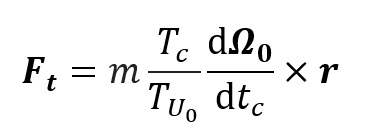 (4.2)
(4.2)For an increasing rate of rotation Ω0, this tangential force will push ahead any particle moving inside a spinning “halo” in the positive direction (Ω0 and the z-axis have the same orientation). The particle will then spiral outward. In the case Ω0 is decreasing, corresponding to an increasing length of the Uo-day, this force will try to push back any test particle. The particle will spiral inward. This will have very interesting applications, especially in physics and astronomy.
Finally, if we hope to obtain accurate laws of nature that can apply at all levels and do not change either when the length of the day changes, we must use in our laws the physical U-time (U-days) related to the spin of U, and not the classical clock time, with no physical relation. Variations in U-time can be measured through longitudinal variations (3.4). A chosen clock serves only to determine the length T of the U-day. If T≈24 hours, then, in the “halo” U, our Newtonian classical laws apply. If T≉24 hours, we just have to use the generalized relation (3.11) for acceleration. We have just to understand that the physical “time” (U-time) inside a “halo” has a feeble chance to coincide with classical time. Therefore, Newtonian’s acceleration has a feeble chance to be accurate. Our need for the Einstein theory of gravity becomes then understandable. Farther the particle is from the axis of rotation of Uo, the greater the error. The heavier the particle is, the greater the error.
The relation (4.2) can also be written as:
 (4.3)
(4.3)For a light particle, not far from the axis of rotation, (4.3) can be neglected provided that d ln Ω0/dtc is small enough. Newtonian’s theory remains then a good approximation. Finally, we want to mention that the U solid body rotation is a very special case. The more general differential rotation case will be studied elsewhere [Kallel-Jallouli 2024a, b].
ACKNOWLEDGEMENT
The paper is not currently submitted to other journals and it will not be submitted to other journals during the reviewing process.
DATA AVAILABILITY
No new data were generated or analyzed in support of this research.
COMPETING INTERESTS
There is no conflict of interest. The author has no relevant financial or non-financial interests to disclose.
FUNDING
The author declares that no funds, grants, or other support were received during the preparation of the manuscript.
REFERENCES
- Barbour, J. B., The End of Time: The Next Revolution in Physics. Oxford University Press (2001)
- DeWitt, B. S. Quantum theory of gravity. I. The canonical theory. Phys. Rev., 160 (5), 1113. (1967)
- Earman, J., World Enough and Spacetime: Absolute vs. Relational Theories of Space and Time. Cambridge, MA: MIT Press; Norton, J. D. (1987)
- Gross, R. S., Earth Roation Variations – Long Period, in Physical Geodesy, edited by T. A. Herring, Treatise on Geophysics, Vol. 11, Elsevier, Amsterdam, (2007).
- Isham, C. J., In: Integrable Systems, Quantum Groups and Quantum Field Theories, edited by L. A. Ibort and M. A. Rodríguez (Kluwer, Dordrecht), grqc/9210011 (1993)
- Kallel-Jallouli, S., Discover the big bang and the secrets of our universe. A new theory. CreateSpace Independent Publishing Platform, (2018)
- Kallel-Jallouli, S., The mystery of time I. A new model to solve the enigma of Dark Matter, Internationl Kindle, Independent Publishing Platform (2021a)
- Kallel-Jallouli, S., A New Solution for Dark Matter and a Better Understanding of Quantum Mechanics, J Pur Appl Math, 5(4): 32-37 (2021b)
- Kallel-Jallouli, S., The Mystery of Time: A New Solution for Dark Matter and a Better Understanding of Quantum Mechanics, J. Phys. Math.12, 3 (2021c)
- Kallel-Jallouli, S. 2023a, A new geometrical time model to explain the discrepancy between theoretical and measured velocities, ResearchGate DOI: 10.13140/RG.2.2.18508.39048
- Kallel-Jallouli, S., 2023b, No more twin paradox, ResearchGate, DOI: 10.13140/RG.2.2.12760.88329
- Kallel-Jallouli S, 2024a, Keplerian motion inside an isolated Dark Matter halo, ResearchGate: DOI: 10.13140/RG.2.2.30102.32320
- Kallel-Jallouli S, 2024b, Phase shift of the Keplerian orbits inside an isolated Dark Matter halo, ResearchGate: DOI: 10.13140/RG.2.2.15244.49287
- Kucha ̌r, K. V., In The Arguments of Time. ed. J. Butterfield, Oxford University Press, Oxford (1999)
- Magueijo, J., and Smolin, L., A Universe that does not know the time, Universe 5 (3) 84 (2019)
- Merali, Z., The origins of space and time: many researchers believe that physics will not be complete until it can explain not just the behaviour of space and time, but where these entities come from. Nature, 500 (7464), 516-520 (2013)
- Rovelli, C., What is observable in classical and quantum gravity?. Class. and Quantum Gravity, 8 (2), 297 (1991)
- Rovelli, C., The Order of Time. Allen Lane publisher, (2018)
- Smolin, L., Time, laws, and the future of cosmology. Phys. Today, 67 (3), 38. (2014)
- Smolin, L., The present moment in quantum cosmology: Challenges to the arguments for the elimination of time. (arXiv:gr-qc/0104097v1) (2001)
- Wheeler, J. A., Lectures in Mathematics and Physics. in: Battelle Rencontres, edited by C. DeWitt and J. A. Wheeler (Benjamin, New York) (1968)
- Young, B. L., A survey of dark matter and related topics in cosmology. Front. of Phys., 12 (2), 121201 (2017).
